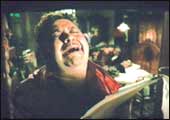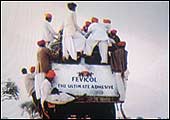|
Some Creative Achievements
|
»
Silver pencil at one show 2002 for anti-smoking
ad
» Three
awards at Asia Pacific adfest
» 17
Abby awards, including 'agency of the year', won for third time
in a row (and sixth time in seven years)
» CLIO
bronze 2002 for the anti-smoking ad
» Two
Gold Lions at Cannes 2002 festival.
» O&M
India considered part of global network;s 'creative cadre' of
15 top O&M worldwide. |
To
habitual advertising award ceremony attendees, they are simply the
people in black. They dress in black, prefer to stand behind the
last row of seats, and make sure everyone else sees and hears them-difficult
not to, especially when the tribe they belong to wins.
The tribe is an agency called Ogilvy &
Mather (O&M, rolled off the tongue preferably, Ohendem) and
despite not being No 1 or No 2-numbers are always kinda suspect
in an industry where the topline is measured in terms of capitalised
billings, not income-it has scorched a hard-to-follow path across
the Indian advertising firmament. Awards? O&M has plenty, including
two Gold Lions at Cannes 2002. Growth? O&M has grown at an average
annual rate of 32 per cent over the past five years, a period when
the industry grew at a mere 20 per cent. Customer-rating? O&M
has just been ranked the 'best' agency in India, according to Agency
Track, a syndicated survey that serves as the industry's scoreboard.
Creative and large? Imaginative and strategic? Entertaining and
persuasive? Gotta be kidding, many an adman would've said. Not Ranjan
Kapur, who can't see success any other way. "Two years ago,"
recalls the Executive Chairman, O&M India, ''we were labelled
a 'creative boutique'. I said, 'Should I take this as an insult
or a compliment?'''
It would have to be one helluva large boutique,
with over Rs 1,000 crore in billings, a heavy-duty strategy think-tank
and a mega-mall of non-advertising shops offering to reach the consumer
every which way-except bubbling up the kitchen sink.
And not Piyush Pandey. ''The idea is to beat
the pattern,'' guffaws the group President & National Creative
Director, O&M. "People said 'it's either-or'. It's never
either-or... it can't be either-or," he says, sobering up to
acknowledge there's a method to it. "It can't be that we get
up every morning and fluke it again," he roars again, almost
rattling the walls.
It's not about turning rocket science into
poetry. But, yes, it's a new way to rock, drawing equally from logicians
and poets, accountants and dreamers, bankers and ponytails-from
divergent resources-to converge on the goal.
|
ALPHA & OMEGA
It's part science and part art
|
"I'd rather entertain and hope that
people learn, than teach and hope people are entertained"
- Walt Disney.
It's what Piyush Pandey looks
at every single day. In strategic terms, entertainment is
typically the 'omega' part, aimed at softening the barriers
to a first-time prospect's mind. This can predominate if the
task is to cast the net wide, for larger numbers. The actual
message is the 'alpha' part, the brand proposition that must
persuade the prospect to action. It's what hauls people together
to the brand's core, and gets loyalty.
 |
|
M-seal: plugging grief
|
 |
|
Fevicol: sticking
together
|
 |
|
Onida KY: enhancing fantasy
|
The emphasis can vary, depending on the stage of market evolution
and the strategy. If Cadbury's advertising, of late, has bored
the 'be yourself' loyalist, it's because it's in omega mode,
fanning out to reach the traditional mithai consumer, while
maintaining thematic consistency. "Making a 'bahana'
(excuse) is another expression of childlike adult behaviour,"
explains Pandey.
Asian Paints, on the other hand, is done with widening out,
and is onto the depth story with its new 'har ghar kuch kehta
hai' ('every house says something') campaign. Says Pandey,
"It's now the leader talking, appreciating the consumer's
own creativity." A Cubist commercial of sorts, it offers
varied take-outs from varied perspectives.
Or take Fevicol, which can't be dislodged now, and thus
has vast space to switch back and forth. This is an issue
of timing the market dynamics correctly, again a science and
art. Pandey cites the analogy of cricketer Viv Richards, who
he admires for the idea of turning "a ball outside the
off-stump into a perfect on-drive".
That's alpha and omega appeal, together. Onida-KY's 'runaway-wife'
spot and M-Seal's 'will' commercial, both, use disaster scenarios
to get a chuckle and make their finer point. It's a technique
that works for one-off ads rather well. Such as Pandey's latest
jury-stunner for the Cancer Patients Aid Association. 'Second
hand smoke kills', it declares, in Marlboro font. The visual?
A cowboy scratching his hat, his horse flat on its side.
|
Even that doesn't quite explain why O&M,
a WPP Group agency, has been piling up account after account and
award after award. Since 1993, business has grown ten-fold-and the
adrenalin's still pumping. The latest boost? It's the first Indian
agency to be invited for a worldwide pitch.
Snip The Hedge
If the 1990s' transformation of O&M has
been a denture-dislodging experience for adfolk of yore, it's by
design. When Kapur returned from O&M Singapore to take over
from S.R. Ayer, in October 1993, the agency was quite the propah
place for strategically safe and executionally dignified advertising.
All under the principled watch of David Ogilvy, the visionary founder
who'd had his agency taken over by Martin Sorrell's WPP Group in
1989, but had left a gene-code so strong that the agency seemed
pre-destined to live by it.
The 'barbarians' were under the command of
'bureaucrats'. And this, to the new chief, was a comfortable way
to be, but no way to grow. Says Pandey, "The best thing that
he brought was a mindset. He said, 'We want to be the biggest-by
way of a great creative product'."
By way of what? People gulped and gasped, but
Kapur delivered his first free-willed jolt by empowering creative-to
move closer to the consumer...the desi consumer, for a change. He
asked Pandey to do his own thing. To think Hindi, write Hindi, and
draw inspiration from the roadside chana-jor-garam vendor who sang
himself silly for sales and survival. That's the game, says Prasoon
Joshi, National Creative Director, McCann-Erickson India, who spent
his formative years at O&M. "It was the only agency that
was Indianising," he remembers, thanking Pandey for showing
him money in poetry.
"People are like caged tigers," says
Kapur, "It's a question of opening the gate and letting them
roam free in the wilderness of advertising."
That did it. Submission turned to defiance-defiance
of convention-as the agency's creative gaze widened. Information
flowed. Ideas erupted. Cadbury's-remember the girl on the cricket
field?-found much-sought-after growth by telling adults that chocolates
were okay. Asian Paints redefined colour consciousness. And Fevicol
gave stickiness myriad dimensions-including an uncrackable egg ('Actually,
the egg came first' the agency wisecracked later).
It was the same spirit that prompted O&M
to rock the ad industry's agency remuneration system. All Kapur
had to do was utter something on fee-based flexibility overthrowing
the traditional '15-per cent commission on billings'-and all hell
broke loose. In effect, O&M was daring other agencies to match
it on both internal cost and market performance-with clients paying
only for advertising that persuades. Horror, sacrilege, and worse,
Kapur wanted everyone to compete!
"We stirred them up," says Kapur,
"We stirred their wrath, we stirred their envy, we stirred
everything you can stir-and the industry grew."
The reality now? At least 30 per cent of the
industry is on fees-or on reduced commissions, reckons Kapur. Cost-efficiency
counts. Creativity is winning business. And clients want to outwit
rivals, not outspend them.
That spells boom-time for O&M. Effective
creativity also means lower cost, says Pandey, citing the example
of Pidilite's M-Seal, a Rs 2-crore media-spend campaign that outsiders
think cost Rs 20 crore. Such work could reduce the agency's take,
but then, reasons Pandey, "If we get 10 new accounts without
a pitch, we save Rs 30 lakh."
Creative spunk is one thing, making money from
it is quite another. And this is another ballgame that Kapur is
busy re-inventing. With varying fee levels, each account must manage
its own p/l now.
Sharpen The Edge
Sharp creativity and business acumen...it's
a terrific strategic advantage. Provided the combination can be
sustained. Can it? Alas, things do go out of whack. Take 1999-2000,
for example. "We swung too dangerously close to just doing
great creative work," confesses Kapur, "without too much
strategic input." Brand planning was in danger of post-rationalising
the agency's creative work, and clients were noticing. "The
task," says Kapur, "is to build a point of view that is
sensitive and intuitive. You do that with the right segment of the
brain-and that must be balanced with the left brain." That's
why Madhukar Sabnavis, an old hand who was running Ogilvy's affiliate
RMG David, had to be brought back to launch the Discovery brain-tank.
Yet, observers suspect O&M's magic has
everything to do with the unique Kapur-Pandey equation. What happens
after Kapur retires? It's what analysts want to know.
Not an issue, feels Kapur, so long as the success
principle gets institutionalised-and O&M remains an agency where
"bankers are comfortable with ponytails, would like to be in
ponytails, and the ponytails feel their comfort levels rising because
the bankers are acting like bankers". It's not about mere reconciliation,
which often means ponytails succumbing to suits, or vice-versa (or
worse, mutual cloning). Nor even about functional equality. Rather,
it's about actual consonance between divergent instincts.
What works within the agency, also works with
clients. "We don't make presentations to each other,"
claims Pandey, "we talk to each other." Corroborates S.
Ramkrishna, Senior Director (Corporate Affairs), Pfizer India, one
of O&M's newest clients, "I've been pleasantly surprised-it's
a dialogue."
No wonder Pfizer's campaign is warming hearts
rather than declaring R&D statistics. Often, what clients need
is an un-business perspective-which helps focus on a single benefit.
Engaging the prospect, after that, is mostly a matter of using entertaining
minimalism, to shoot the brand's message straight into consumer
mindspace.
Fight The Wedge
To be sure, O&M isn't invincible. Some critics
detect complacency setting in. Nirvik Singh, Managing Director,
Grey Worldwide, admires O&M's clutter-busting skills, but wonders
about pan-portfolio consistency. "Are they doing outstanding
work for all their clients? The answer is 'no'," he says.
Others call it an 'award junkie', distracted
from business issues, even as rivals such as Lowe and McCann charge
ahead on cost-efficiency. The biggest criticism, though, concerns
brand planning, on which HTA is still seen as the leader (think
Pepsi). Titan, for example, has floundered. Some of O&M's other
work seems aimed only at getting a laugh, not reshaping attitudes.
Can Discovery do something? "It's about
institutionalising knowledge," says Sabnavis, defending O&M's
long-range planning brainware. Asian Paints, for instance, has taken
a planned step up, from celebrating festivals to celebrating the
consumer's own self-expressive urge. "The objective is to increase
the involvement of paint in the realm of home décor,"
says K.B.S. Anand, Vice President (Sales & Marketing), Asian
Paints (I) Ltd, which has had a 25-year relationship with O&M.
The other thing Kapur must worry about is the
classic problem of its whizkids remaining media-obsessed, although
the agency's '360 degrees' approach is designed to draw revenues
from non-advertising tools-on which WPP is bullish big-time. Kapur
calls the idea a "real point of difference", giving the
example of Ogilvy Outreach, which can deploy an army of 15,000 people
for fieldwork to cover some 80,000 villages a year. Good. But the
fact is: all the sparks are still coming from good ol' advertising.
And that domain is shrinking too, with Mindshare
taking over the media-buying function for all WPP agencies-as ordained
by Sorrell. Slowly, Kapur is having to cede his free-space to global
forces. Already, says Arvind Sharma, Chairman & CEO, Leo Burnett,
"The size game is being played more at the group level."
Having recently taken over Rediffusion-Dentsu-Y&R, WPP has around
a third of the Indian ad pie, with Interpublic and Omnicom having
just woken up to the region. Growth dynamics could still change.
Are Kapur and Pandey really in control of O&M's
destiny? Hmmm. They have little influence over business allocation
at the global level. So perhaps the real wedge is global alignment,
by which a brand assigns its account to the same network worldwide,
regardless of market conditions. "I call it global terrorism,"
growls Pandey. Lack of local meritocracy could yet call the show
off. Of course, the world could start taking India more seriously
too.
Keep The Pledge
To Kapur, the climax of his career is still
ahead: becoming India's top agency. When this unifying goal was
set, back in 1993, O&M was on the fourth rung-with billings
of Rs 100 crore. Below HTA, Lintas, and even Mudra. "There
are very few brands," says Kapur, "that set themselves
that kind of target: 'I'm No 4, I'm going for No 1. Y'know, it wasn't
'I'm going for No 2 or No 3', no, it was 'I'm going for No 1'."
Reductio ad claritum. Like much of O&M's
advertising. Except that the goal is no longer scoff-worthy, though
HTA has been the biggest ever since anybody can remember, and Lowe
still claims higher billings (Mudra was overtaken some years ago).
"They have a great shot at becoming the
largest," says Grey's Singh. "Perceptual leadership we
have attained-undoubtedly," says Kapur, referring to the AgencyTrack
survey. "And having attained that, we're going for actual leadership."
All said, HTA could still get 'too sexy for
its brief', as it wants to. But Kapur says he'll worry only when
the agency starts using the Pepsi magic on other brands. In any
case, O&M doesn't see anything sacred about the so-called 'Agency
Report' rankings; the ladder is just another object of human conception,
after all. "Nobody reports actual numbers," alleges Kapur,
matter-of-factly, "They're all lightly touched up. This debate
can go on...but we want to be so far ahead that nobody will deny
us that particular rank."
Ah, a matter of perceptions. And perhaps it's
this attitude, this freedom from self-made fixations, that's the
real stuff of consonance at O&M. Like an upside down free-speech
ribbon-well-looped below, open-ended on top.
|

